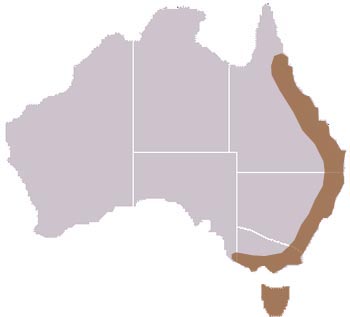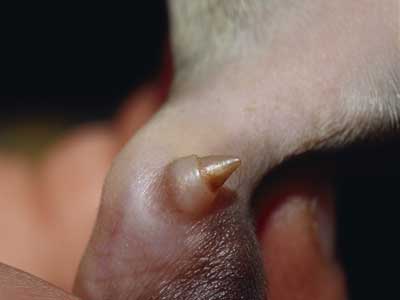Location and Habitat
The platypus is common to the southern parts of Australia and sometimes the northern parts. However, the platypus is also present in parts of Tasmania. Platypuses occupy permanent lakes, streams, and rivers. Within the range of their territory, platypuses generally occupy several burrows (up to about 12). The abundance of burrows allows the platypus to always be in the vicinity of a safe area should something dangerous approach and it also reduces the likelihood of parasitic infection of the burrows. Each burrow can be classified as either a nesting burrow or a dwelling burrow. These burrows can reach lengths up to 20 meters long. Dwelling burrows are generally difficult to spot since they can be concealed by overhanging vegetation or built underwater. Nesting burrows are used for raising young platypuses, sometimes informally coined as "platypups," while dwelling burrows are used for everyday activities such as eating and resting. A current topic of research is how platypuses have been able to adapt to the varying amounts of oxygen present in their burrows. The lack of oxygen can especially have an effect during breeding season because the female platypus plugs the burrow whenever she leaves it and also because the young platypuses remain in the burrow for approximately three months. Decreasing amounts of oxygen may have an effect on the young platypuses. Some researchers have speculated that the platypus may have adopted its blood makeup to survive with limited oxygen.
Platypuses generally live alone, and if territories overlap it is the responsibility of the younger platypus to find new territory. They spend over 40% of their time in the water, and are often mistaken for logs by the casual passerby. Platypuses have been observed remaining underwater for up to 14 minutes before resurfacing, although they usually only remain submerged for about a minute when they are foraging for food. The platypus has blood rich with iron-containing hemoglobin molecules conducive to extensive diving expeditions. Another adaptation platypuses have for diving is the ability to significantly lower their heart rates from about 200 beats per minute to 10 beats per minute. Platypuses maintain a body temperature of about 32 degrees Celsius which helps them retain heat when underwater.
Platypus habitats and platypuses themselves are threatened in various ways. Platypus burrows are affected by seasonally altered river flows, declining water quality, loss of native vegetation, and increased erosion on the banks of waterways. Other common causes of death for platypuses include attacks by foxes and cats. Platypuses also get entangled in fishing nets and traps. A fishhook stuck in the bill of a platypus can restrict breathing and feeding and quickly lead to the death of the affected platypus.

Platypuses are found on the coasts in Eastern Australia. Recent research suggests that geographically isolated species of platypuses could actually be different species.
Description
The appearance of the semi-aquatic platypus is generally regarded as odd and was in fact believed to be a hoax when discovered by the Europeans in 1798. Scientists proclaimed that the platypus was actually several animals sewn together. George Shaw was one of the first scientists to publish a description of the platypus in 1799 in Naturalist's Miscellany. Shaw describes the platypus: "The body is depressed, and has some resemblance to that of an Otter in miniature: it is covered with very thick, soft, and beaver-like fur, and is of a moderately dark brown above, and of a subferuginous white beneath." The name "platypus," coined by Dr. Shaw, comes from the Greek platy meaning "flat" and pous meaning "foot." The scientific name of the platypus is Ornithorhynchus anatinus.
The platypus is an egg-laying mammal (monotreme) about the size of a small house cat. Males average 50 centimeters in length and weigh about 2 kilograms while females are usually about 43 centimeters in length and weigh 1 kilogram. Platypuses have two layers of extremely dense fur, averaging 600-900 hairs per square millimeter of skin. The double layer of fur on platypuses functions to keep the animal dry even when it is diving. The long, coarse outer hairs cover the finer fur underneath.
A platypus's tail is made primarily of fat. These fat deposits are used to determine how healthy a platypus is; researchers administer a "squeeze-test" to the tail of a platypus and assign the platypus a number 1 through 5 based on the abundance of fat deposits in the tail. More fat deposits indicate a healthier platypus, as the platypus uses its tail fat to sustain itself during the winter months. A platypus uses its tail for steering while it is underwater, for hoarding leaves when constructing a burrow, and (in females) for holding eggs during incubation. Some accounts claim that the platypus also uses its tail to slap the water when it feels danger is imminent, but this is generally regarded as a myth.
The four webbed feet of a platypus are conducive to swimming. When the platypus is in the water it uses its front feet to propel itself forward while its back legs (only partially webbed) function in steering. However, when a platypus is out of the water, the webbing on its feet is tucked underneath its feet to prevent damage. This also allows it to better utilize its claws for digging. Males also have a 1.5 centimeter long spur behind each webbed foot which creates venom composed of 250 different chemicals and 4 toxins. The venom is strong enough to kill a small dog, but generally does not kill humans. A human spurred by a platypus suffers unendurable pain and may be incapacitated. The affected area swells and the pain may develop into hyperalgesia and persist for several weeks. Past attempts to relieve the pain of platypus spurs with morphine have failed dismally. There have not yet been any fatalities based on platypus venom reported.
The platypus has a flexible, rubbery bill sometimes inaccurately described as "duck-like." The distinct difference between a platypus bill and a duck bill is that the bill of a duck is a hard structure composed of keratin, while the bill of a platypus is pliable and packed with electroreceptor cells. The electroreception system of a platypus, located in its bill, contains about 850,000 sensors which allow it to detect blips of electricity emitted from the animals it feeds on. In an experiment, this "sixth sense" allowed a blindfolded platypus to detect a nearly discharged AAA battery as if it were its prey. This electroreception system is what allows platypuses to hunt effectively, since they feed primarily at night and close their eyes while diving. The bill of a platypus is gray and has two nostrils situated slightly behind the tip of its bill. The bill also sports a "bill shield" which extends up to the forehead of the platypus.
Platypuses are certainly capable of making sounds. They have been reported to make a low growling noise when they are in danger which can be heard at this site under "Venom Glands and Spurs." Platypuses are also known to make a sneezing sound; the primary function of this is most likely to remove residual water from their nostrils. The Australian Platypus Conservancy located in Victoria says of the elusive platypus sneeze, "It's a very quiet sound that would need high quality recording equipment to capture effectively. Plus the sound engineer would have to be in exactly the right place at the right time, as the sneeze is not something that occurs with any degree of predictability." Due to this lack of sneezing predictability, there are sadly no sound recordings currently available of platypuses sneezing.

Platypus spurs cause intense pain, but not death, in humans.
Life and Death
Platypus reproduction is special for several reasons. As previously stated, platypuses are one of the only egg-laying mammals. Females produce a "clutch" of approximately two eggs in late winter or spring. Platypus eggs have a leathery outside and therefore more closely resemble eggs of reptiles than those of birds. Platypus eggs are 15-18 millimeters in length and are incubated by the mother for about 11 days.
A female platypus does not have nipples, but still possesses the mammary glands characteristic of mammals in the form of patches on her stomach. Young platypuses slurp up the milk from these two patches. Platypus milk is rich in iron, and in fact has 60 times more iron than cow milk. Male platypuses do not help raise young platypuses.
The platypus life span ranges from 4-5 years for males and 6-8 years for females. However, there are records of platypuses living as long as 16 or 17 years in the wild.
Platypus populations are affected by predators, floods, disease, and litter. Predators of the platypus include birds of prey, pythons, monitors, crocodiles, foxes, dogs, cats, and Australian water-rats. These predators may attack young platypuses in their burrows, or in the case of the birds of prey, capture them in the water. Floods can affect platypuses negatively by destroying burrows and platypus habitat areas. However, floods can also increase the foraging area for platypuses and thus facilitate in increased food intake. There have not been many instances of disease affecting platypus populations. However, in Tasmania a fungal disease called Mucor amphibiorum causes ulcers in platypuses. Another serious threat to platypuses is litter in rivers, such as fish hooks and plastic rings. Fish hooks can get caught in a platypus's bill and prevent proper breathing and feeding, leading to the death of the platypus.

Young platypuses are generally known as "puggles."